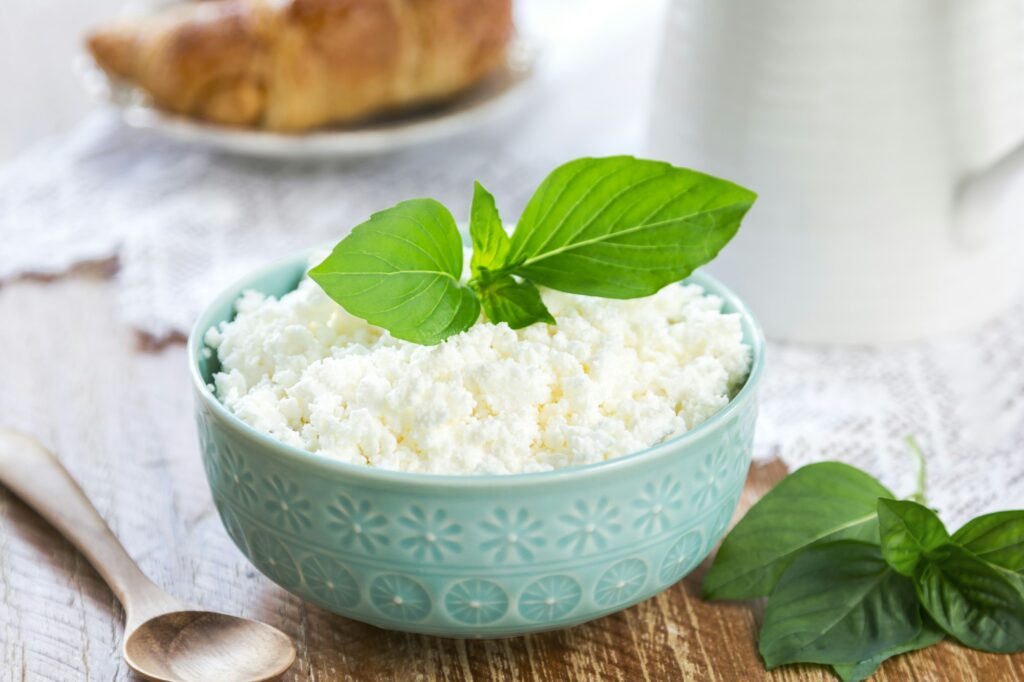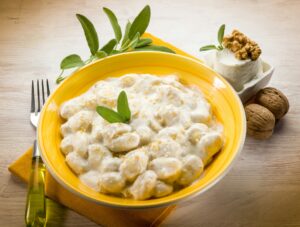Have you ever found yourself with an abundance of ricotta cheese and wondered, “What can I do with too much ricotta?” You’re not alone. This creamy, Italian cheese is a staple in many kitchens, known for its mild flavor and versatile uses. However, it’s not uncommon to buy more ricotta than needed, leaving us puzzled over how to utilize the surplus. Fear not, for ricotta cheese is incredibly versatile, capable of transforming into a myriad of delicious dishes, both savory and sweet. This article will guide you through innovative and mouthwatering ways to use up that extra ricotta, ensuring nothing goes to waste.
The Versatility of Ricotta Cheese
Ricotta cheese, with its creamy texture and mild flavor, is a marvel in the culinary world. Originating from Italy, this protein-rich cheese is made from whey, a byproduct of cheese-making, making it a unique addition to the cheese family. Its nutritional benefits are vast, offering a good source of protein and essential nutrients. Here’s why ricotta is a must-have in your fridge:
- Creamy Italian Cheese: Its texture adds a smooth, creamy element to dishes.
- Mild Flavor: Ricotta’s subtlety makes it a perfect canvas for both bold and delicate flavors.
- Protein-Rich: An excellent source of protein, making it a great choice for meals any time of the day.
- Whey Cheese: Made from whey, ricotta is lighter than many other cheeses, making it a healthier option.
Savory Ways to Use Excess Ricotta
Diving into the realm of savory recipes, ricotta proves to be a star ingredient. Here are some delectable ways to incorporate this creamy cheese into your meals:
Whipped Ricotta with Honey:
This quick appetizer draws inspiration from Mediterranean cuisine, blending the savory cheese with golden honey for a creamy texture that’s simply irresistible. Serve it with warm bread for a delightful start to any meal.
Lemon Ricotta Pancakes:
Transform your breakfast with these high-protein, fluffy and light pancakes. Infused with citrus flavor, they’re not just delicious but also protein-packed, making them an easy recipe for a nutritious start to the day.
Lemon Ricotta Pasta:
For a quick weeknight meal, this pasta dish is a game-changer. The white sauce made from ricotta, mixed with lemon zest, coats the long noodles perfectly, offering a zesty and creamy dish that’s hard to resist.
Ricotta Toast Variations:
Whether you prefer sweet or savory, ricotta toast can be customized to suit your taste. Top it with ripe tomatoes, smoked salmon, or a mix of fruit and honey for a versatile and satisfying meal.
Classic Lasagna with Ricotta:
A traditional dish with a twist, this lasagna uses a spinach ricotta filling flavored with fresh thyme and garlic nuance, showcasing ricotta’s ability to elevate a classic to new heights.
Ricotta Pizza:
Combine creamy ricotta with stretchy mozzarella and tangy artichokes for a pizza that’s a testament to ricotta’s versatility. This three-cheese blend creates a pizza experience unlike any other.
Each of these recipes highlights the savory and creamy texture of ricotta, making it clear why this cheese should never go to waste. Whether you’re whipping up a quick appetizer or a comforting main dish, ricotta cheese is your ally in the kitchen, bringing a touch of Italian flair to your table.
Sweet Recipes to Use Excess Ricotta
Transitioning from savory to sweet, ricotta cheese demonstrates its remarkable flexibility in desserts. Its creamy texture and mild flavor make it an excellent base for a variety of sweet treats. Here are some indulgent ways to use ricotta in your desserts:
Ricotta in Desserts:
Introducing ricotta into desserts opens up a world of possibilities. From fruit cobblers to cakes and cookies, ricotta adds a creamy and moist dimension that enhances the overall taste and texture of sweet dishes.
Peach Cobbler with Ricotta Biscuits:
Imagine a seasonal dessert where cinnamon-spiced peaches meet delightfully flaky ricotta biscuits. This combination creates a seasonal dessert that’s both comforting and sophisticated, showcasing ricotta’s versatility beyond traditional uses.
Ricotta Cheesecake and More:
Elevate your dessert game with a ricotta cheesecake, where ricotta’s creamy filling makes for a lighter alternative to traditional cheesecake. Additionally, raspberry ricotta cake and lemon ricotta cookies offer a moist and light texture, proving that ricotta can be a star in traditional Italian desserts and beyond.
These sweet applications of ricotta cheese not only cater to those with a sweet tooth but also highlight the ingredient’s adaptability. Whether you’re baking a cake, whipping up a batch of cookies, or assembling a fruit cobbler, ricotta cheese can transform your dessert into something truly special.
Innovative Ways to Use Excess Ricotta
Ricotta cheese, with its creamy texture and mild flavor, transcends traditional culinary boundaries, offering a canvas for innovative culinary creations. Moving beyond the familiar terrain of savory and sweet dishes, ricotta invites adventurous cooks to explore its potential in unique and unexpected ways. Here, we delve into some inventive methods to weave this versatile cheese into your culinary repertoire, showcasing its adaptability and the endless possibilities it presents.
Ricotta Dumplings in Tomato Basil Sauce:
Imagine a dish where comfort food meets culinary innovation. Ricotta dumplings serve as a testament to this, offering a soul-soothing experience with every bite. These pillowy morsels, bathed in a savory tomato basil sauce, echo the essence of a deconstructed pizza. Yet, they stand out with their own distinct, innovative flair. The juxtaposition of the creamy ricotta against the tangy sauce creates a harmonious blend that’s both homey and comforting, yet decidedly gourmet.
Homemade Ricotta Gnocchi:
For those in pursuit of a quick and easy pasta alternative, homemade ricotta gnocchi emerges as a brilliant solution. This dish exemplifies ricotta’s prowess in transforming simple ingredients into light, delicate versions of beloved classics. Paired with your choice of marinara or bolognese sauce, ricotta gnocchi embodies the essence of traditional pasta while offering a lighter, more nuanced experience. It’s a celebration of simplicity and elegance, where ricotta plays a pivotal role in elevating the dish to new heights.
These examples merely scratch the surface of ricotta’s versatility. They invite us to reconsider our approach to this Italian cheese, encouraging us to experiment and innovate. Here are additional ideas to inspire your culinary adventures with ricotta:
- Ricotta-Infused Breads: Incorporate ricotta into bread dough for a moist, tender crumb that adds a subtle richness to your baked goods.
- Savory Ricotta Fritters: Combine ricotta with herbs and spices to create savory fritters, perfect for dipping in a variety of sauces.
- Ricotta-Based Sauces: Use ricotta as a base for creamy sauces, adding depth and creaminess to pasta dishes and casseroles without the heaviness of traditional cream sauces.
The innovative uses of ricotta cheese underscore its remarkable flexibility and capacity to transform the ordinary into the extraordinary. Whether you’re crafting dumplings, gnocchi, or venturing into new culinary territories, ricotta stands ready to elevate your cooking with its creamy texture and mild flavor. It’s a testament to the creativity and innovation that ricotta inspires in the kitchen, proving that with a bit of imagination, the possibilities are truly limitless.
The Remarkable Health Benefits of Ricotta Cheese: Use Excess Ricotta Now
Ricotta cheese is more than just a versatile and delightful addition to your culinary creations; it’s a powerhouse of nutrition that offers numerous health benefits. Incorporating ricotta into your diet is not merely about indulging in its creamy goodness but also about embracing a healthier lifestyle. Here’s a deeper dive into why ricotta cheese should be a staple in your nutrition plan:
Nutritional Richness of Ricotta
- Protein Power: Ricotta is an excellent source of high-quality protein, essential for muscle repair and growth. This makes it an ideal choice for athletes, fitness enthusiasts, and anyone looking to maintain or build muscle mass.
- Calcium Content: With its rich calcium content, ricotta supports bone health, aiding in the prevention of osteoporosis and other bone-related conditions.
- Vitamin Rich: Ricotta is packed with essential vitamins such as Vitamin A, B vitamins, especially B12, and Vitamin D. These vitamins play crucial roles in maintaining eye health, energy levels, and supporting the immune system.
Supporting Muscle Growth and Cardiovascular Health
- High-Quality Whey: The high-quality whey protein in ricotta is not only fantastic for muscle growth but also has properties that may help in lowering blood pressure. This contributes significantly to cardiovascular health, making ricotta a heart-friendly food.
- Low in Sodium: Compared to many other cheeses, ricotta is relatively low in sodium, reducing the risk of hypertension and supporting heart health.
- Rich in Omega-3 Fatty Acids: Certain varieties of ricotta, especially those made from the milk of grass-fed animals, contain omega-3 fatty acids. These are known for their anti-inflammatory properties and benefits to heart health.
Enhancing Your Diet: Use Excess Ricotta
Incorporating ricotta cheese into your diet offers a blend of taste and health benefits that few other foods can match. Whether you’re looking to build muscle, maintain a healthy weight, or simply enjoy a nutritious diet, ricotta provides:
- A versatile ingredient that can be added to both savory and sweet dishes.
- A way to enrich your meals with essential nutrients without compromising on flavor.
- An opportunity to enjoy a cheese that is both creamy and healthful, fitting perfectly into a balanced diet.
By choosing ricotta cheese, you’re not just opting for delicious meals; you’re also making a decision that benefits your overall health. From its role in muscle building and maintenance to its contributions to bone health and cardiovascular wellness, ricotta is indeed a worthy addition to your diet. Whether you’re exploring muscle-building foods or seeking ingredients that support heart health, ricotta cheese stands out as a nutritious and delicious choice.
FAQs Regarding Using Excess Ricotta
To round off our exploration of ricotta cheese, here are some frequently asked questions:
Q: Can ricotta cheese be frozen for later use?
A: Indeed, ricotta cheese can be frozen, extending its shelf life beyond the refrigerator’s confines. However, it’s important to note that freezing may alter its texture. While the taste remains largely unaffected, the cheese might become slightly grainier upon thawing. This change doesn’t detract from its utility in cooked dishes, where ricotta can still perform beautifully in recipes requiring a creamy texture.
Q: How can I make ricotta cheese at home?
A: Crafting homemade ricotta is surprisingly straightforward and rewarding. It requires minimal ingredients—typically whole milk, an acid like lemon juice or vinegar, and a pinch of salt. The process involves heating the milk, adding the acid to separate the curds from the whey, and then straining. The result? Fresh, creamy ricotta that can elevate any dish, from savory to sweet.
Q: What are the best herbs and spices to pair with ricotta?
A: The mild flavor of ricotta makes it a perfect canvas for a wide array of herbs and spices. For a savory twist, basil and thyme bring out the cheese’s freshness, while for sweet applications, cinnamon and vanilla complement its creaminess. Experimenting with different combinations can lead to delightful discoveries in both traditional Italian desserts and innovative dishes.
Q: Is ricotta cheese suitable for people with lactose intolerance?
A: Ricotta is often more tolerable for individuals with lactose intolerance due to its lower lactose content compared to many other cheeses. Its gentle nature makes it a feasible option for those looking to enjoy cheese without the usual discomfort. However, sensitivity levels vary, and it’s wise to start with small amounts to gauge tolerance.
Conclusion: Time to Use Excess Ricotta
Ricotta cheese stands as a culinary chameleon, seamlessly blending into an array of dishes that cover the full spectrum from savory delights to sweet treats. Its creamy texture, mild flavor, and impressive nutritional benefits elevate it to a staple ingredient in any culinary repertoire. Delving into the myriad of recipes and creative applications highlighted in this guide, you’re poised to discover enticing ways to make the most of surplus ricotta cheese. When faced with an abundance of ricotta, view it not as a dilemma but as a canvas for culinary creativity, urging you to explore and invent new beloved recipes. The potential of ricotta cheese is bound only by the limits of your imagination, encouraging a journey of gastronomic discovery.
Ricotta’s ability to adapt to both savory and sweet applications makes it an invaluable asset in the kitchen. From enhancing a simple pasta dish to becoming the star of a decadent dessert, ricotta’s versatility is unmatched. The mild flavor of ricotta cheese acts as a blank canvas, inviting a plethora of flavors and textures. Whether paired with the zest of lemon in a light pasta or blended into a rich, sweet cheesecake, ricotta complements and elevates. Beyond its culinary flexibility, ricotta offers a wealth of nutritional benefits. High in protein and calcium, it supports muscle health and bone density, making it a guilt-free addition to any meal.
In conclusion, ricotta cheese is more than just an ingredient; it’s a source of inspiration, a pathway to healthier eating, and a testament to the joys of culinary exploration. So, the next time you’re pondering over what to do with excess ricotta, let your creativity lead the way. Dive into the diverse recipes and innovative uses outlined, and let the versatile, creamy, and nutritious ricotta cheese transform your meals into extraordinary culinary experiences.



